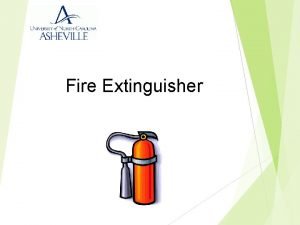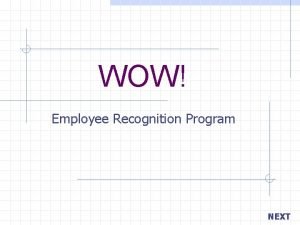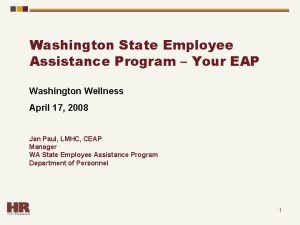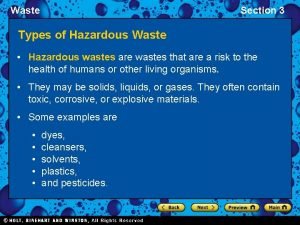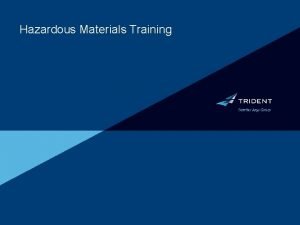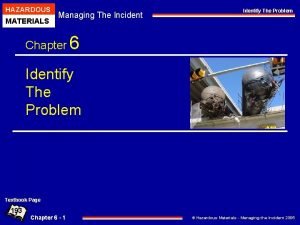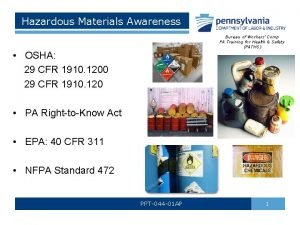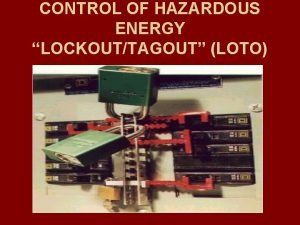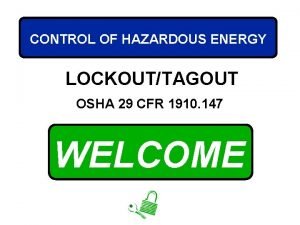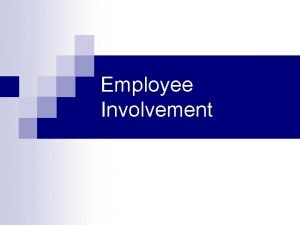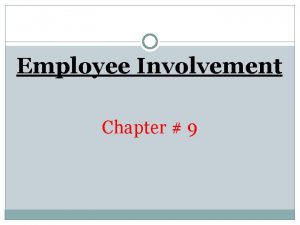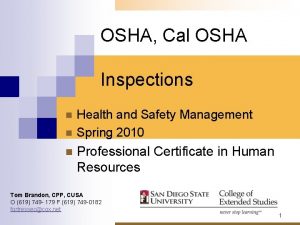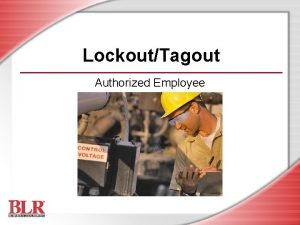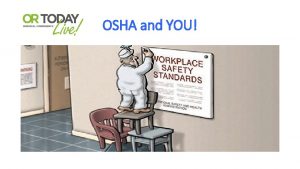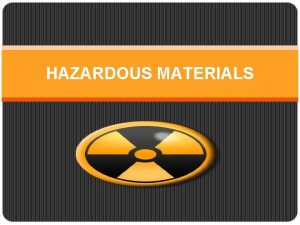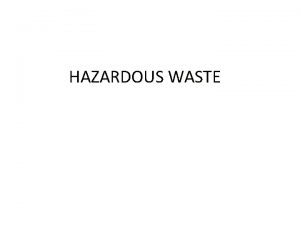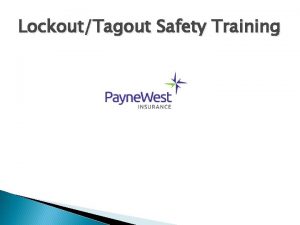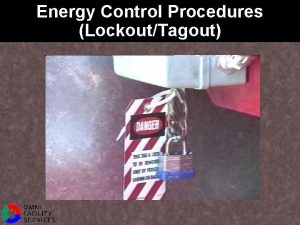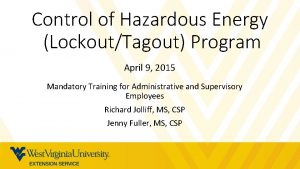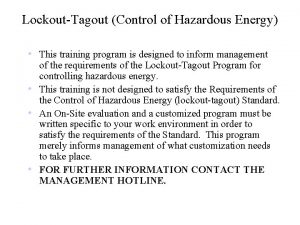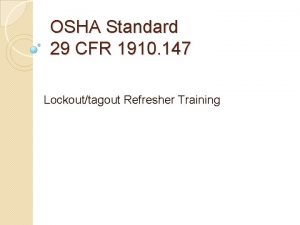LockoutTagout OSHA Regulations LockoutTagout Program Employee Involvement Hazardous



















- Slides: 19

Lockout/Tagout • OSHA Regulations • Lockout/Tagout Program • Employee Involvement • Hazardous Energy Sources • Controlling Energy Sources • General Lockout Procedures • Cord & Plug • Tagout Only System

Lockout/tagout is intended to protect workers from injury when exposed to potential machine hazards. Lockout/tagout procedures are implemented when: • A machine needs to be serviced or repaired • Clearing a jam from the machine • Employees must remove protective guards • Employees enter hazard zones The workers in these situations are potentially exposed to the hazards of the machine, such as: • The point of operation with cutting, shaping, or bending hazards • Nip points like a belt and pulley or chain and sprocket • Reciprocating motion like robot arms that move back and forth • Rotating motion such as rotating shafts Lockout/tagout will prevent machinery from unexpectedly starting up and thus causing a serious injury. • Someone working on an electrical panel could be shocked and injured if the panel was unexpectedly energized with electricity. • A worker changing a valve in a steam line could be seriously burned if the steam line were unexpectedly energized with steam. • Robotic equipment or computer-controlled equipment could unexpectedly move or start up and seriously injure a worker who is in the hazard zone. Stored energy must be dissipated because it may also cause equipment to move and then injure a worker who is in the hazard zone. • Hydraulic pressure in the system, when released, may cause equipment to move. • Stored air pressure can also cause equipment to move when the air pressure is released. • A mechanical device, such as a spring, that is under tension may be released and cause movement in the machine.

Lockout/Tagout (cont. ) • OSHA Regulations • Specific Standards • Written lockout/tagout program • Written machine-specific lockout/tagout procedures • Employee training plan • Lockout/tagout devices that meet specific standards • Lockout/Tagout Program

OSHA Regulations OSHA’s standard, the control of hazardous energy (lockout/tagout) can be found in 29 CFR 1910. 147. The standard is very specific and includes requirements such as: • Written lockout/tagout program • Written machine-specific lockout/tagout procedures • Employee training plan • Lockout/tagout devices that meet specific standards Because the lockout/tagout standard saves worker lives, OSHA is very serious about enforcing the lockout/tagout standard and making sure employers are implementing lockout/tagout requirements in the workplace. Every year OSHA issues many citations to companies that have violated the lockout/tagout standard. In fact, lockout/tagout is almost always in the list of the top 10 most frequently violated OSHA standards for general industry. Lockout/Tagout Program OSHA requires employers to develop a lockout/tagout program that includes the following key components: • General procedures for locking out and controlling the hazardous energy on equipment and machines • Specific procedures that describe how to specifically lock out each machine • An employee training plan • Annual inspections of written procedures and employee competence • The types of hazardous energy sources that could cause the unexpected energizing, start-up, or release of stored energy • Procedures for successfully isolating the energy sources of a machine in order to render it inoperative

Lockout/Tag out (cont. ) Employee Involvement Authorized Employees – • Employees must be “authorized” before they are permitted to implement lockout/tagout procedures on machines or equipment in order to repair or service the machine. Machine operators themselves can be “authorized” to perform lockout/tagout procedures on their machines as long as they receive all the required training. • “Authorized” employees receive specific training, which often includes both a written and hands-on test to prove they understand the procedures and can correctly implement the procedures. • Training should include: • • Review of the OSHA lockout/tagout standard • • Review of the company’s written lockout/tagout program • • How to identify hazardous energy sources • • How to isolate and control energy sources • • General procedures • • Machine-specific lockout/tagout procedures • • The nature and limitation of tagout • • How to remove lockout and restart the machine • • Review group lockout procedures Continued on next slide

Lockout/Tagout (cont. ) Employee Involvement Retraining “Authorized” employees should receive refresher training each year to keep their knowledge of machine hazards and general lockout/tagout procedures sharp. OSHA requires “authorized” employees to be retrained: • If the employee changes job assignments or moves to a different department that has different types of equipment • If there is installation of any new machines, equipment, or processes that present new hazards or require modified lockout procedures • When specific lockout/tagout procedures are changed • If the employee incorrectly performs a lockout/tagout procedure Affected Employees All other employees are considered by OSHA to be “affected” by lockout/tagout because they may work in an area where lockout/tagout procedures are conducted by “authorized” employees on nearby machinery. “Affected” employees also include operators of machines that require repair or servicing by an employee who is “authorized” to perform lockout/tagout. “Affected” employees are not permitted to implement lockout/tagout procedures on a machine. “Affected” employees must receive training that includes : • How lockout/tagout protects the lives of those repairing or servicing equipment • The basics of how lockout/tagout works • Instructions to never perform lockout/tagout themselves • Instructions to never tamper with a machine or start a machine that is locked or tagged out • Instructions to never remove a lock or tag

Lockout/Tagout (cont. ) • Hazardous Energy Sources • • Electricity Hydraulic systems pressurized Pneumatic or compressed air, systems Mechanical systems such as springs that are under compression Chemical systems such as pipes, tanks and valves Thermal devices – equipment with potential for heat or frost burns Steam systems Gravity – equipment components that could fall or come down on workers

Lockout/Ta gout (cont. ) Controlling Energy Sources The only way for a worker to prevent injury when servicing a machine while exposed to machinery hazards is to control the energy sources of that machine. Here are some examples of different ways to control energy sources. Electricity—Electricity can be controlled a couple ways. Move the electrical disconnect switch to the “off” position and apply a lock through the disconnect switch so it cannot be moved back to the “on” position. Or flip the circuit breaker “off ” and use a special locking device that prevents the breaker from being switched back “on. ” Chemicals—Workers are protected from chemicals, steam, and air by merely closing the valve to prevent the chemical, steam, or air from entering the equipment. Some valves are designed to be locked once they are in the “closed” position, while others will require a special lockout device to prevent them from being moved to the “open” position. Hydraulic or pneumatic—Machines with hydraulic- or pneumatic-controlled devices will often still have pressure in the systems even after valves are locked to prevent more air or hydraulics from entering the equipment. This pressure may cause a part of the machine to move, so it is important to bleed off the pressure that remains in the machine. Mechanical energy—Release pressure that still remains in mechanical systems, such as that in springs. Allow them to return to their normal or natural position. Gravity—Some machine components may be in an “up” position due to hydraulic or pneumatic pressure. However, once the pressure is released, the machine component may fall on a worker. Control this hazard by blocking the component in the “up” position so it will not come down on a worker. Thermal energy—Heating elements and other hot machine components must be given appropriate time to cool before workers can enter the area.

Lockout/Tago ut (cont. ) • • • General Lockout Procedures . Identify hazards and get lockout equipment. Plan the job by reading the specific procedure, identifying potential energy sources, and gathering the lockout equipment needed to properly lock out the machine. 2. Notify “affected” employees. Notify nearby “affected” employees that a lockout/tagout procedure is going to be implemented and that they should stay clear of the machine. 3. Turn off the machine. Shut down the machine using the normal procedures. 4. Turn off all energy sources. Locate all energy sources and move them to the “off” position, close valves, release stored energy, block up gravity, etc. 5. Apply locks to control energy. Apply locks or tags to the energy sources in order to prevent them from being moved back to the “on” position. 6. Test operating controls. After applying the locks to the energy sources, test the operating controls on the machine to verify that the energy has been isolated and does not pose a hazard. 7. Perform repair or service. Perform the necessary work or service until completed. 8. Remove tools, install guards, notify workers. Prepare to remove the locks and tags by removing all tools from the hazardous area around the machine, replacing all guards back onto the machine, and warning nearby workers that the energy sources will soon be returned to the machine. 9. Remove locks and apply energy. Remove lockout/tagout devices and turn the energy sources back to the “on” position. 10. Start up equipment. Start up the equipment by following the normal operating procedures. Test the equipment to be sure everything functions properly. 1

Lockout/Tagout (cont. ) Machine-specific Procedures OSHA requires that specific lockout/tagout procedures be developed and used for each machine, equipment, or process in the company. The specific procedure must include a statement that explains the intended use of the procedure. For example, apply lockout for changing cutting head. Or, apply lockout for general electrical repair or servicing. Of course the specific procedures will include all the elements of the general lockout procedures; however, additional details will be added to each step that are specific to each machine. The specific procedures will also include: • Steps for shutting down, isolating, blocking, and securing the equipment in order to control the hazardous energy • Steps for the placement, removal, and transfer of lockout devices • Steps to test the machine in order to verify that the lockout/tagout process has effectively controlled the energy sources Exception to Specific Procedures OSHA requires that specific lockout/tagout procedures be developed and utilized for every machine unless it meets all of the following specific elements. Many companies develop specific procedures for every machine just to be consistent, rather than trying to prove that a machine meets the exception. • The machine or equipment must have no potential for stored or residual energy. • The machine must have a single energy source, which is easily identified and isolated. The isolation and locking out of the energy source will completely de-energize the machine. The machine must be isolated from that single energy source and locked out during servicing or maintenance. • A single lockout device will achieve a locked-out condition. The lockout device is under the control of the “authorized” employee performing the service or maintenance. • The servicing or maintenance does not create hazards for other employees. • The company, while utilizing this exception, has not had any accidents involving the unexpected activation or re-energization of the machine or equipment during repair or service.

Lockout/Tagout (cont. ) Cord and Plug Lockout/tagout is not required when working on cord and plug equipment as long as the following requirements are met: • Unplugging the equipment from the energy source controls exposure to the hazards of unexpected energization or start-up of the equipment. • The plug is under the exclusive control of the employee performing the repair or service on the equipment. Despite this exception, it is always a good practice to prevent the machine from being plugged in by applying a plug lockout device. Tagout Only Systems Tagout systems, without the application of a lock, can only be used on machines or energy sources that do not have the ability to be physically locked in the “off” position. When implementing tagout, a tag is placed on a control button or some other device that has been moved into the “off” position. The tag has a printed warning that usually includes the word “danger” and then describes what could happen if the energy source were to be put in the “on” position. Tagout systems do not protect the worker from injury: • Tags do not prevent another employee from re-energizing the machine. An employee might not see the tag, the tag might fall off, or an employee might just ignore the tag. • Tags do not prevent a machine from unexpectedly energizing, starting up, or releasing stored energy. Some employers do not allow the use of tagout and require all equipment to have energy sources that can be physically locked out.

Lockout/Tagout (cont. ) • Locks • Removing Locks • Group Lockout • Changing Shifts • Outside Contractors • Annual Inspections

Locks The locks and tags used by the employees in the lockout/tagout process at your company must meet certain requirements. • Locks must be standardized. They must have the same color, size, or shape throughout the facility so that all workers can easily recognize them as lockout/tagout devices. Bike locks or locker locks, for example, are not appropriate locks to use in a lockout/tagout program. • Locks must be durable. They must be able to stand up to the weather and the hazards of an industrial work environment. • Locks must be strong. The locks must be strong enough so they cannot be easily removed. • Locks must be identified. Identify locks with the name or picture of the person that applied the lock. Instead of putting the identification directly on the lock, a tag may be used with the lock that identifies the user of the lock. Identification tags should be attached to locks or equipment with something like nylon cable that is strong and cannot be reused.

Removing Locks Only the “authorized” employee that applied the lockout/tagout is permitted to remove the lock. The only exception is when the “authorized” employee that applied the lock is not available. In that case, a designated person in management may remove the lock by following these specific procedures. 1. Verify that the “authorized” person that applied the lock is not in the workplace. 2. Contact the “authorized” person and have him or her return to the facility to remove the lock or give permission for the lock to be removed. 3. If permission is granted, then the designated management representative can remove the lock by cutting it with bolt cutters. 4. If the employee cannot be reached, management must notify the employee that the lock was removed before the employee returns to work.

Group Lockout • Two or more people cannot work under the locks applied by one person. A person cannot work under the protection of someone else’s locks. You can only work on a machine or enter the machine’s hazard zones if you have applied locks to the hazardous energy sources. • Each person must apply a lock to every isolated source of hazardous energy. If five people are in a machine that has electrical and pneumatic hazards, then there must be five locks on the electrical disconnect switch and five locks on the valve controlling the pneumatic system. • Group lockout/tagout devices can be done with a lockout hasp, which allows up to six workers to apply locks to a single energy source. Group lockout can also be done with a lockout box in which one lock is applied to every energy source and the keys for those locks are placed in a specially designed box, then each “authorized” employee places one lock on the outside of the box. All employees must remove their locks from the box before it can be opened and the keys inside accessed. • Group lockout requires all “authorized” employees and outside contractors to be working under one person who is responsible for the overall lockout procedure. • Before starting the procedure, all “authorized” employees must review the specific procedure together so everyone understands the lockout requirements.

Changing Shifts Shift changes must be coordinated between the “authorized” employees that are responsible for the group lockout of each shift. For single lockouts, the shift change only needs to be coordinated between the two individuals; however, the process is the same. 1. The ending shift removes their locks from every hazardous energy source per the written lockout procedure. The responsible “authorized” employee for the ending shift removes his locks last. 2. The starting shift applies their locks onto every hazardous energy source per the written lockout procedure. The responsible “authorized” employee for the starting shift installs his locks first. 3. The responsible “authorized” employee for the starting shift ensures that all employees are clear of the hazards of the machine, then verifies that all energy sources have been controlled and are de-energized by testing the operating controls on the equipment. 4. Now it is safe for the starting shift to work on the equipment.

Outside Contractors • Company “authorized” employees must work closely with outside contractors to ensure lockout/tagout procedures are performed correctly for the safety of all workers involved. • The contractor and the company should exchange written lockout/tagout programs. Then the company and contractor need to meet and determine the optimum lockout/tagout procedure to apply to the specific equipment. Once the procedure is agreed to, then both company and contractor employees must follow the agreed-upon procedure. • All company and contractor “authorized” employees must be trained on the agreed-upon procedure.

Annual Inspections • OSHA requires employers to make sure the specific written procedures that have been written for each machine are inspected on an annual basis to verify that each written procedure is still correct. • OSHA also requires that the competency of each “authorized” employee is inspected annually to ensure that the employee can still conduct lockout/tagout procedures correctly. • The inspection is to be done by another “authorized” employee who will observe both the written procedure and the “authorized” employee. The inspection of both the employee and the written procedure must be documented. • If the procedure is inadequate, the inspector will immediately correct the procedure and inform all other “authorized” employees of any changes made to the specific lockout/tagout procedure. If the “authorized” employee deviates from the written procedure, then the employee will be corrected immediately and retrained.

Review slides and prepare to take the quiz on lockout/tagout training. 19
 How can employee involvement measures motivate employees
How can employee involvement measures motivate employees Fire extinguisher distance osha
Fire extinguisher distance osha Employee attitudes and employee performance
Employee attitudes and employee performance Osha alliance program
Osha alliance program Osha vpp program benefits disadvantages
Osha vpp program benefits disadvantages Proposal for employee recognition program
Proposal for employee recognition program Washington state employee assistance program
Washington state employee assistance program Employee assistance program townsville
Employee assistance program townsville Usf employee assistance program
Usf employee assistance program Careways employee assistance program
Careways employee assistance program Cdw employee purchase program
Cdw employee purchase program Aurora employee assistance program
Aurora employee assistance program Challenges of career management
Challenges of career management Section 3 hazardous waste answers
Section 3 hazardous waste answers Aviation hazardous attitudes
Aviation hazardous attitudes Dr neha agrawal
Dr neha agrawal Hazardous material table
Hazardous material table Hazardous materials table
Hazardous materials table Us military marking system for hazardous materials
Us military marking system for hazardous materials Hazwoper
Hazwoper

